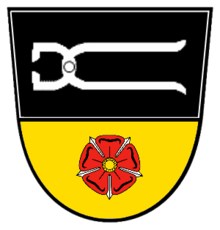Hammer tongs stone
The Hammer Zangenstein was located in the district of the same name in the Upper Palatinate community of Schwarzhofen . The hammer was operated by the water of the Schwarzach .
history
The iron hammer from Zangenstein was owned by Ott Zenger in 1360 , Conrad der Amann is mentioned here in 1382 and Hans Zenger in 1391 and 1404 . The place pliers stone is also mentioned as Altmann and Otto Katz village and its cousin the Katzdorferin Elisabeth 1424 an eternal Mass at the Church of Katzdorf donated, while the large and the small tithes to Meuschendorf, the plier stone and on the hammer in mice village, with to which they were enfeoffed by the Bishop of Regensburg in 1410, bequeathed to the church.
Johann Friedrich von Aufseß on Freyenfels and Zangenstein , treasurer, district judge and governor of Neunburg vom Wald broke through the rock under the castle in 1684 and had the Schwarzach diverted into a canal. In 1686 he had the chapel on the castle expanded in its current form. In 1687 he had a nail hammer built. But already in 1689 Johann Friedrich sold Zangenstein to Johann Adam von Saur , envoy of several imperial princes at the Reichstag in Regensburg. He delegated his administrator to negotiate a hammer cleaning facility to be set up in 1693, and his widow Maria Elisabeth was named as the owner in the state parliament in 1707 . This is followed by the son Christoph von Spaur (* 1680, † 1752), who, after an educational trip through Italy with the Prince of Lamberg, took over the estate and the hammer. He got rid of administrators and tenants and managed his estates (economy, brewery, hammer, nail smithy) himself. According to his records, 600 fl could be earned with the hammer . He was followed by his son Bonaventura von Saur († 1780), councilor of Amberg. Because of his frequent absence, he let a manager look after the economy and the brewery; he leased the mill, fishing water, hammer and nail forge. A storm in 1740 and competition from the ironworks in Bodenwöhr since 1754 led to a shortage of charcoal and economic difficulties. After his death, his widow Franziska, née von Boslarn, managed the property until 1787, when her son Anton Ignaz von Saur († 1836) took over the property. However, he also leased the economy and brewery. In 1806 he let the hammer go down and in its place built a three-speed grinding mill and a cutting saw. The nail smithy and the Zainhammer remained in operation until 1831. He was followed by Franz Ignaz von Sauer , who, however, had settled on the Fronhofen estate he had bought. In 1837 he converted the nail forge that had closed down into a hammer business, but now the ore was melted using a blue furnace . The stove was circular and 14 feet high to the gout , and waste wood was also burned. He hired Johann Mann as a competent tenant . The iron required was obtained from Amberg, and he also had the iron-containing slag processed. Since Christoph von Spauer, the necessary charcoal came partly from lordly forests, and then also from private forests that were leased by the farmers in Auerbach. The hammer produced between five and six hundred quintals a year of iron, which was sold for 9 fl 10 kr per quintal, plus a wage to Regensburg of 30 kr and to Straubing of 40 kr.
literature
- Ignatz von Voith: The hammer at Meuschendorf and the hammer at Zangenstein. Negotiations of the Historical Association of the Upper Palatinate , 1841, Volume 6, pp. 183–198.
Coordinates: 49 ° 23 '52.9 " N , 12 ° 18' 33" E
